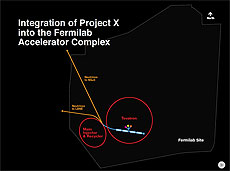This story first appeared in Fermilab Today on April 12.
According to the Nuclear Energy Institute, U.S. nuclear power plants have produced roughly 70,000 tons of radioactive waste over the last four decades. By 2025, scientists expect the amount of waste to be roughly 100,000 tons. The nuclear industry faces an ever-increasing waste problem, and Fermilab’s proposed Project X is developing the technologies that may contribute to a solution.
View this animation to see how Fermilab's Project X would be integrated into the laboratory's accelerator complex.
Last week at AccApp’11, an accelerator applications conference hosted by the American Nuclear Society and the International Atomic Energy Agency, Fermilab’s David Johnson explained how Project X could demonstrate the technologies required for accelerator-driven nuclear waste treatments.
“Fermilab has proposed the construction of a high-power proton linac for support of our high-energy physics program, and we are exploring the possibility to expand the application of the project to nuclear physics and energy applications,” Johnson said.
Project X is a proposed high-intensity proton accelerator complex that would support experiments in neutrino and rare processes physics. By using highly efficient superconducting radio frequency cavities, the technology of choice for next-generation accelerators, Project X would create a continuous-wave beam of protons. While the Project X mission is focused on particle physics, the beam that will be produced has uses that go beyond particle physics. The continuous-wave beam—as opposed to a pulsed one—makes it possible for Project X to also support experiments validating assumptions that underlie accelerator-driven waste treatment concepts. It would also demonstrate the associated accelerator and target technologies, Johnson said.
By hitting a lead-bismuth target with protons, a high-power, continuous-wave linac would create fast, or highly energetic neutrons. These fast neutrons would burn up the dangerous radioactive elements in nuclear waste, significantly reducing its half-life. In order to meet the requirements for treating nuclear waste on the industrial scale, the accelerator must operate reliably with virtually no downtime. Johnson explained that by advancing technologies and producing stable accelerator operations, Project X could serve as a proof of concept for the application.
“We would like to get the nuclear community excited about this potential facility,” Johnson said. “We welcome any and all participation.”







